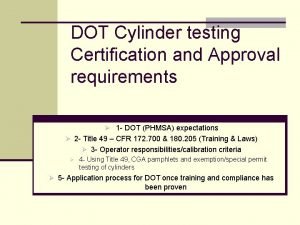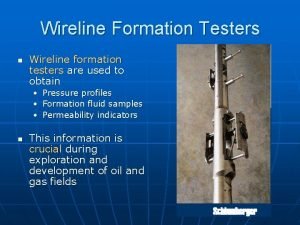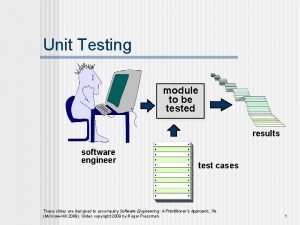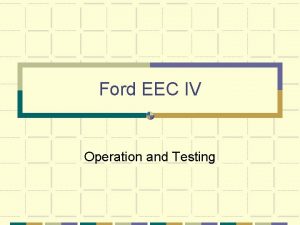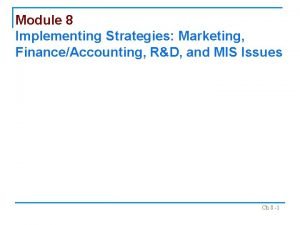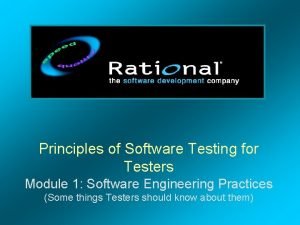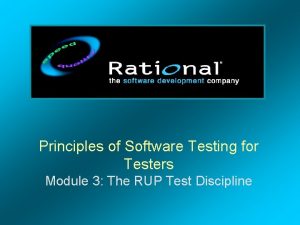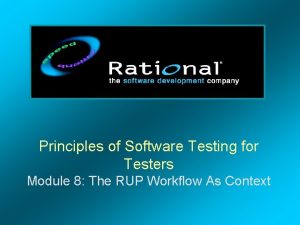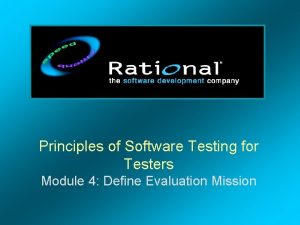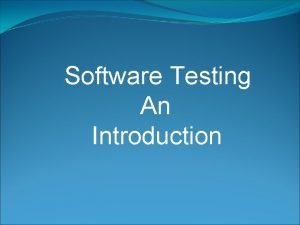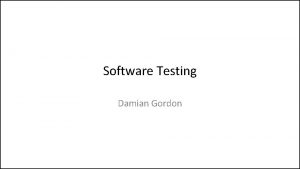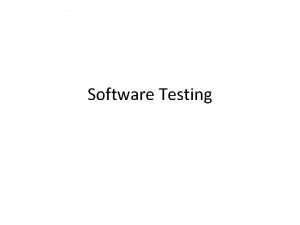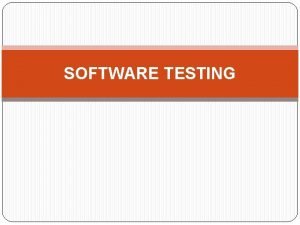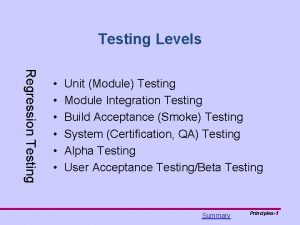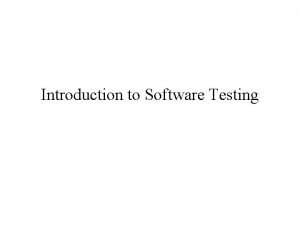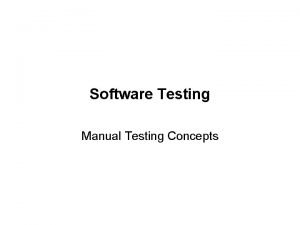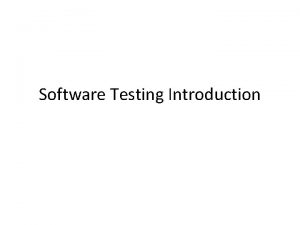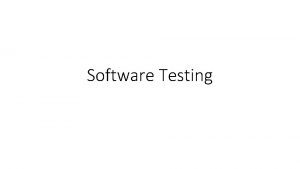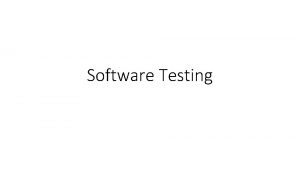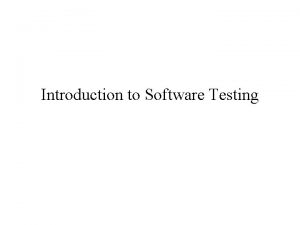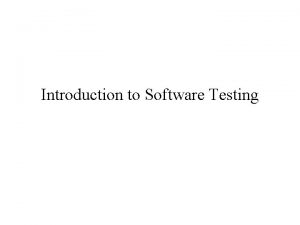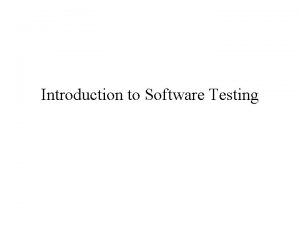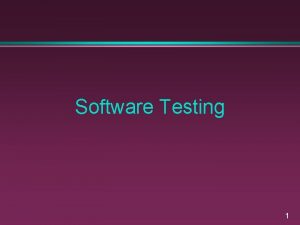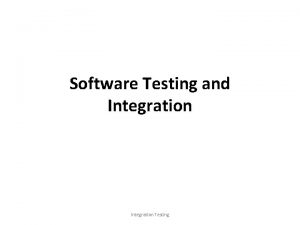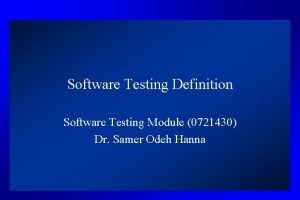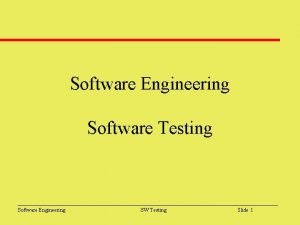Principles of Software Testing for Testers Module 5




























































- Slides: 60

Principles of Software Testing for Testers Module 5: Test & Evaluate

Module 5 Agenda w Overview of the workflow: Test and Evaluate w Defining test techniques—the primary types and styles of functional testing w Individual techniques w Using techniques together w In the next module: § Analyze test failures § Report problems Principles of Software Testing for Testers Copyright © 2002 Rational Software, all rights reserved 2

Review: Where We’ve Been w In the last module, we covered the workflow detail Define Evaluation Mission w The Mission focuses on the high-level objectives of the test team for the current iteration § What things should motivate us to test? § Why these things (and not others)? Principles of Software Testing for Testers Copyright © 2002 Rational Software, all rights reserved 3

Test and Evaluate – Part One: Test w In this module, we drill into Test and Evaluate w This addresses the “How? ” question: § How will you test those things? Principles of Software Testing for Testers Copyright © 2002 Rational Software, all rights reserved 4

Test and Evaluate – Part One: Test w This module focuses on the activity Implement Test w Earlier, we covered Test-Idea Lists, which are input here w In the next module, we’ll cover Analyze Test Failures, the second half of Test and Evaluate Principles of Software Testing for Testers Copyright © 2002 Rational Software, all rights reserved 5

Module 5 Agenda w w Overview of the workflow: Test and Evaluate Defining test techniques Individual techniques Using techniques together Principles of Software Testing for Testers Copyright © 2002 Rational Software, all rights reserved 6

Review: Defining the Test Approach w In Module 4, we covered Test Approach w A good test approach is: § Diversified § Risk-focused § Product-specific § Practical § Defensible w The techniques you apply should follow your test approach Principles of Software Testing for Testers Copyright © 2002 Rational Software, all rights reserved 7

Discussion Exercise 5. 1: Test Techniques w There as many as 200 published testing techniques. Many of the ideas are overlapping, but there are common themes. w Similar sounding terms often mean different things, e. g. : § User testing § Usability testing § User interface testing w What are the differences among these techniques? Principles of Software Testing for Testers Copyright © 2002 Rational Software, all rights reserved 8

Dimensions of Test Techniques w Think of the testing you do in terms of five dimensions: § Testers: who does the testing. § Coverage: what gets tested. § Potential problems: why you're testing (what risk you're testing for). § Activities: how you test. § Evaluation: how to tell whether the test passed or failed. w Test techniques often focus on one or two of these, leaving the rest to the skill and imagination of the tester. Principles of Software Testing for Testers Copyright © 2002 Rational Software, all rights reserved 9

Test Techniques—Dominant Test Approaches w Of the 200+ published Functional Testing techniques, there are ten basic themes. w They capture the techniques in actual practice. w In this course, we call them: § Function testing § Equivalence analysis § Specification-based testing § Risk-based testing § Stress testing § Regression testing § Exploratory testing § User testing § Scenario testing § Stochastic or Random testing Principles of Software Testing for Testers Copyright © 2002 Rational Software, all rights reserved 10

“So Which Technique Is the Best? ” w Each has strengths and weaknesses w Think in terms of complement Technique A Technique H Technique B Testers Coverage Technique G Technique C Potential problems w There is no Activities “one true way” Technique Evaluation F Technique D w Mixing techniques can improve coverage Principles of Software Testing for Testers Copyright © 2002 Rational Software, all rights reserved Technique E 11

Apply Techniques According to the Life. Cycle w Test Approach changes over the project w Some techniques work well in early phases; others in later ones w Align the techniques to iteration objectives Inception Elaboration Construction A limited set of focused tests Transition Many varied tests A few components of software under test Large system under test Simple test environment Complex test environment Focus on architectural & requirement risks Focus on deployment risks Principles of Software Testing for Testers Copyright © 2002 Rational Software, all rights reserved 12

Module 5 Agenda w Overview of the workflow: Test and Evaluate w Defining test techniques w Individual techniques § § § § § Function testing Equivalence analysis Specification-based testing Risk-based testing Stress testing Regression testing Exploratory testing User testing Scenario testing Stochastic or Random testing w Using techniques together Principles of Software Testing for Testers Copyright © 2002 Rational Software, all rights reserved 13

At a Glance: Function Testing Tag line Potential problems Activities Evaluation Complexity Black box unit testing Test each function thoroughly, one at a time. Any Each function and user-visible variable A function does not work in isolation Whatever works Simple Harshness SUT readiness Varies Any stage Objective Testers Coverage Principles of Software Testing for Testers Copyright © 2002 Rational Software, all rights reserved 14

Strengths & Weaknesses: Function Testing w Representative cases § Spreadsheet, test each item in isolation. § Database, test each report in isolation w Strengths § Thorough analysis of each item tested § Easy to do as each function is implemented w Blind spots § Misses interactions § Misses exploration of the benefits offered by the program. Principles of Software Testing for Testers Copyright © 2002 Rational Software, all rights reserved 15

Module 5 Agenda w Overview of the workflow: Test and Evaluate w Defining test techniques w Individual techniques § § § § § Function testing Equivalence analysis Specification-based testing Risk-based testing Stress testing Regression testing Exploratory testing User testing Scenario testing Stochastic or Random testing w Using techniques together Principles of Software Testing for Testers Copyright © 2002 Rational Software, all rights reserved 16

At a Glance: Equivalence Analysis (1/2) Tag line Objective Testers Coverage Principles of Software Testing for Testers Copyright © 2002 Rational Software, all rights reserved Potential Partitioning, boundary analysis, domain testing There are too many test cases to run. Use stratified sampling strategy to select a few test cases from a huge population. Any All data fields, and simple combinations of data fields. Data fields include input, output, and (to the extent they can be made visible to the tester) internal and configuration variables Data, configuration, error 17

At a Glance: Equivalence Analysis (2/2) Activities Evaluation Complexity Harshness Principles of Software Testing for Testers Copyright © 2002 Rational Software, all rights reserved SUT Divide the set of possible values of a field into subsets, pick values to represent each subset. Typical values will be at boundaries. More generally, the goal is to find a “best representative” for each subset, and to run tests with these representatives. Advanced approach: combine tests of several “best representatives”. Several approaches to choosing optimal small set of combinations. Determined by the data Simple Designed to discover harsh singlevariable tests and harsh combinations of a few variables 18

Strengths & Weaknesses: Equivalence Analysis w Representative cases § Equivalence analysis of a simple numeric field. § Printer compatibility testing (multidimensional variable, doesn’t map to a simple numeric field, but stratified sampling is essential) w Strengths § Find highest probability errors with a relatively small set of tests. § Intuitively clear approach, generalizes well w Blind spots § Errors that are not at boundaries or in obvious special cases. § The actual sets of possible values are often unknowable. Principles of Software Testing for Testers Copyright © 2002 Rational Software, all rights reserved 19

Optional Exercise 5. 2: GUI Equivalence Analysis w Pick an app that you know and some dialogs § MS Word and its Print, Page setup, Font format dialogs w Select a dialog § Identify each field, and for each field • What is the type of the field (integer, real, string, . . . )? • List the range of entries that are “valid” for the field • Partition the field and identify boundary conditions • List the entries that are almost too extreme and too extreme for the field • List a few test cases for the field and explain why the values you chose are the most powerful representatives of their sets (for showing a bug) • Identify any constraints imposed on this field by other fields Principles of Software Testing for Testers Copyright © 2002 Rational Software, all rights reserved 20

Optional Exercise 5. 3: Data Equivalence w The program reads three integer values from a card. The three values are interpreted as representing the lengths of the sides of a triangle. The program prints a message that states whether the triangle is scalene, isosceles, or equilateral. w From Glenford J. Myers, The Art of Software Testing (1979) w Write a set of test cases that would adequately test this program. Principles of Software Testing for Testers Copyright © 2002 Rational Software, all rights reserved 21

Exercise 5. 3: Myers’ Answers w Test case for a valid scalene triangle w Test case for a valid equilateral triangle w Three test cases for valid isosceles triangles § (a=b, b=c, a=c) w One, two or three sides has zero value (5 cases) w One side has a negative w Sum of two numbers equals the third (e. g. 1, 2, 3) § Invalid b/c not a triangle (tried with 3 permutations a+b=c, a+c=b, b+c=a) w Sum of two numbers is less than the third § (e. g. 1, 2, 4) (3 permutations) w Non-integer w Wrong number of values (too many, too few) Principles of Software Testing for Testers Copyright © 2002 Rational Software, all rights reserved 22

Optional Exercise 5. 4: Numeric Range with Output w The program: §K = I * J § I, J and K are integer variables w Write a set of test cases that would adequately test this program Principles of Software Testing for Testers Copyright © 2002 Rational Software, all rights reserved 23

Module 5 Agenda w Overview of the workflow: Test and Evaluate w Defining test techniques w Individual techniques § § § § § Function testing Equivalence analysis Specification-based testing Risk-based testing Stress testing Regression testing Exploratory testing User testing Scenario testing Stochastic or Random testing w Using techniques together Principles of Software Testing for Testers Copyright © 2002 Rational Software, all rights reserved 24

At a Glance: Specification-Based Testing Tag line Objective Testers Coverage Potential problems Activities Evaluation Complexity Harshness Principles of Software Testing for Testers Copyright © 2002 Rational Software, all rights reserved Verify every claim Check conformance with every statement in every spec, requirements document, etc. Any Documented reqts, features, etc. Mismatch of implementation to spec Write & execute tests based on the spec’s. Review and manage docs & traceability Does behavior match the spec? Depends on the spec 25

Strengths & Weaknesses: Spec-Based Testing w Representative cases § Traceability matrix, tracks test cases associated with each specification item. § User documentation testing w Strengths § Critical defense against warranty claims, fraud charges, loss of credibility with customers. § Effective for managing scope / expectations of regulatory-driven testing § Reduces support costs / customer complaints by ensuring that no false or misleading representations are made to customers. w Blind spots § Any issues not in the specs or treated badly in the specs /documentation. Principles of Software Testing for Testers Copyright © 2002 Rational Software, all rights reserved 26

Traceability Tool for Specification-Based Testing The Traceability Matrix Stmt 1 Stmt 2 Stmt 3 Stmt 4 Stmt 5 Test 1 X X Test 2 X X X Test 3 X X X Test 4 X X Test 5 X Test 6 X Principles of Software Testing for Testers Copyright © 2002 Rational Software, all rights reserved X X 27

Optional Exercise 5. 5: What “Specs” Can You Use? w Challenge: § Getting information in the absence of a spec § What substitutes are available? w Example: § The user manual – think of this as a commercial warranty for what your product does. w What other “specs” can you/should you be using to test? Principles of Software Testing for Testers Copyright © 2002 Rational Software, all rights reserved 28

Exercise 5. 5—Specification-Based Testing w Here are some ideas for sources that you can consult when specifications are incomplete or incorrect. § Software change memos that come with new builds of the program § User manual draft (and previous version’s manual) § Product literature § Published style guide and UI standards w For more, see the Notes on this page of the Course Notes. Principles of Software Testing for Testers Copyright © 2002 Rational Software, all rights reserved 29

Module 5 Agenda w Overview of the workflow: Test and Evaluate w Defining test techniques w Individual techniques § § § § § Function testing Equivalence analysis Specification-based testing Risk-based testing Stress testing Regression testing Exploratory testing User testing Scenario testing Stochastic or Random testing w Using techniques together Principles of Software Testing for Testers Copyright © 2002 Rational Software, all rights reserved 32

Definitions—Risk-Based Testing w Three key meanings: 1. Find errors (risk-based approach to the technical tasks of testing) 2. Manage the process of finding errors (risk-based test management) 3. Manage the testing project and the risk posed by (and to) testing in its relationship to the overall project (risk-based project management) w We’ll look primarily at risk-based testing (#1), proceeding later to risk-based test management. w The project management risks are very important, but of scope for this class. Principles of Software Testing for Testers Copyright © 2002 Rational Software, all rights reserved 33

At a Glance: Risk-Based Testing Tag line Objective Testers Coverage Potential problems Activities Evaluation Complexity Harshness Principles of Software Testing for Testers Copyright © 2002 Rational Software, all rights reserved Find big bugs first Define, prioritize, refine tests in terms of the relative risk of issues we could test for Any By identified risk Identifiable risks Use qualities of service, risk heuristics and bug patterns to identify risks Varies Any Harsh 34

Strengths & Weaknesses: Risk-Based Testing w Representative cases § Equivalence class analysis, reformulated. § Test in order of frequency of use. § Stress tests, error handling tests, security tests. § Sample from predicted-bugs list. w Strengths § Optimal prioritization (if we get the risk list right) § High power tests w Blind spots § Risks not identified or that are surprisingly more likely. § Some “risk-driven” testers seem to operate subjectively. • How will I know what coverage I’ve reached? • Do I know that I haven’t missed something critical? Principles of Software Testing for Testers Copyright © 2002 Rational Software, all rights reserved 35

Optional Exercise 5. 6: Risk-Based Testing w You are testing Amazon. com (Or pick another familiar application) w First brainstorm: § What are the functional areas of the app? w Then evaluate risks: • What are some of the ways that each of these could fail? • How likely do you think they are to fail? Why? • How serious would each of the failure types be? Principles of Software Testing for Testers Copyright © 2002 Rational Software, all rights reserved 41

Module 5 Agenda w Overview of the workflow: Test and Evaluate w Defining test techniques w Individual techniques § § § § § Function testing Equivalence analysis Specification-based testing Risk-based testing Stress testing Regression testing Exploratory testing User testing Scenario testing Stochastic or Random testing w Using techniques together Principles of Software Testing for Testers Copyright © 2002 Rational Software, all rights reserved 42

At a Glance: Stress Testing Tag line Objective Testers Coverage Potential problems Activities Evaluation Complexity Harshness SUT readiness Principles of Software Testing for Testers Copyright © 2002 Rational Software, all rights reserved Overwhelm the product Learn what failure at extremes tells about changes needed in the program’s handling of normal cases Specialists Limited Error handling weaknesses Specialized Varies Extreme Late stage 43

Strengths & Weaknesses: Stress Testing w Representative cases § Buffer overflow bugs § High volumes of data, device connections, long transaction chains § Low memory conditions, device failures, viruses, other crises § Extreme load w Strengths § Expose weaknesses that will arise in the field. § Expose security risks. w Blind spots § Weaknesses that are not made more visible by stress. Principles of Software Testing for Testers Copyright © 2002 Rational Software, all rights reserved 44

Module 5 Agenda w Overview of the workflow: Test and Evaluate w Defining test techniques w Individual techniques § § § § § Function testing Equivalence analysis Specification-based testing Risk-based testing Stress testing Regression testing Exploratory testing User testing Scenario testing Stochastic or Random testing w Using techniques together Principles of Software Testing for Testers Copyright © 2002 Rational Software, all rights reserved 45

At a Glance: Regression Testing Tag line Objective Testers Coverage Potential problems Activities Complexity Evaluation Harshness SUT readiness Principles of Software Testing for Testers Copyright © 2002 Rational Software, all rights reserved Automated testing after changes Detect unforeseen consequences of change Varies Side effects of changes Unsuccessful bug fixes Create automated test suites and run against every (major) build Varies For unit – early; for GUI - late 46

Strengths & Weaknesses—Regression Testing w Representative cases § Bug regression, old fix regression, general functional regression § Automated GUI regression test suites w Strengths § Cheap to execute § Configuration testing § Regulator friendly w Blind spots § “Immunization curve” § Anything not covered in the regression suite § Cost of maintaining the regression suite Principles of Software Testing for Testers Copyright © 2002 Rational Software, all rights reserved 47

Module 5 Agenda w Overview of the workflow: Test and Evaluate w Defining test techniques w Individual techniques § § § § § Function testing Equivalence analysis Specification-based testing Risk-based testing Stress testing Regression testing Exploratory testing User testing Scenario testing Stochastic or Random testing w Using techniques together Principles of Software Testing for Testers Copyright © 2002 Rational Software, all rights reserved 48

At a Glance: Exploratory Testing Tag line Objective Testers Coverage Potential problems Activities Evaluation Complexity Harshness SUT readiness Principles of Software Testing for Testers Copyright © 2002 Rational Software, all rights reserved Simultaneous learning, planning, and testing Simultaneously learn about the product and about the test strategies to reveal the product and its defects Explorers Hard to assess Everything unforeseen by planned testing techniques Learn, plan, and test at the same time Varies Medium to late: use cases must work 49

Strengths & Weaknesses: Exploratory Testing w Representative cases § Skilled exploratory testing of the full product § Rapid testing & emergency testing (including thrownover-the-wall test-it-today) § Troubleshooting / follow-up testing of defects. w Strengths § Customer-focused, risk-focused § Responsive to changing circumstances § Finds bugs that are otherwise missed w Blind spots § The less we know, the more we risk missing. § Limited by each tester’s weaknesses (can mitigate this with careful management) § This is skilled work, juniors aren’t very good at it. Principles of Software Testing for Testers Copyright © 2002 Rational Software, all rights reserved 50

Module 5 Agenda w Overview of the workflow: Test and Evaluate w Defining test techniques w Individual techniques § § § § § Function testing Equivalence analysis Specification-based testing Risk-based testing Stress testing Regression testing Exploratory testing User testing Scenario testing Stochastic or Random testing w Using techniques together Principles of Software Testing for Testers Copyright © 2002 Rational Software, all rights reserved 51

At a Glance: User Testing Strive for realism Tag line Let’s try real humans (for a change) Identify failures in the overall Objective human/machine/software system. Testers Users Coverage Very hard to measure Items that will be missed by Potential problems anyone other than an actual user Activities Directed by user User’s assessment, with Evaluation guidance Complexity Varies Principles of Software Testing for Testers Copyright © 2002 Rational Software, all rights reserved 52

Strengths & Weaknesses—User Testing w Representative cases § Beta testing § In-house lab using a stratified sample of target market § Usability testing w Strengths § Expose design issues § Find areas with high error rates § Can be monitored with flight recorders § Can use in-house tests focus on controversial areas w Blind spots § Coverage not assured § Weak test cases § Beta test technical results are mixed § Must distinguish marketing betas from technical betas Principles of Software Testing for Testers Copyright © 2002 Rational Software, all rights reserved 53

Module 5 Agenda w Overview of the workflow: Test and Evaluate w Defining test techniques w Individual techniques § § § § § Function testing Equivalence analysis Specification-based testing Risk-based testing Stress testing Regression testing Exploratory testing User testing Scenario testing Stochastic or Random testing w Using techniques together Principles of Software Testing for Testers Copyright © 2002 Rational Software, all rights reserved 54

At a Glance: Scenario Testing Instantiation of a use case Tag line Do something useful, interesting, and complex Objective Challenging cases to reflect real use Testers Any Coverage Whatever stories touch Potential Complex interactions that happen in problems real use by experienced users Interview stakeholders & write Activities screenplays, then implement tests Evaluation Any Complexity High Harshness Varies SUT Late. Requires stable, integrated readiness functionality. Principles of Software Testing for Testers Copyright © 2002 Rational Software, all rights reserved 55

Strengths & Weaknesses: Scenario Testing w Representative cases § Use cases, or sequences involving combinations of use cases. § Appraise product against business rules, customer data, competitors’ output § Hans Buwalda’s “soap opera testing. ” w Strengths § Complex, realistic events. Can handle (help with) situations that are too complex to model. § Exposes failures that occur (develop) over time w Blind spots § Single function failures can make this test inefficient. § Must think carefully to achieve good coverage. Principles of Software Testing for Testers Copyright © 2002 Rational Software, all rights reserved 56

Optional Exercise 5. 7: Soap Operas for Testing 1. 2. 3. 4. Pick a familiar product Define a scope of the test Identify with the business environment Include elements that would make things difficult 5. Tell the story Principles of Software Testing for Testers Copyright © 2002 Rational Software, all rights reserved 60

Module 5 Agenda w Overview of the workflow: Test and Evaluate w Defining test techniques w Individual techniques § § § § § Function testing Equivalence analysis Specification-based testing Risk-based testing Stress testing Regression testing Exploratory testing User testing Scenario testing Stochastic or Random testing w Using techniques together Principles of Software Testing for Testers Copyright © 2002 Rational Software, all rights reserved 61

At a Glance: Stochastic or Random Testing (1/2) Tag line Objective Principles of Software Testing for Testers Copyright © 2002 Rational Software, all rights reserved Monkey testing High-volume testing with new cases all the time Have the computer create, execute, and evaluate huge numbers of tests. The individual tests are not all that powerful, nor all that compelling. The power of the approach lies in the large number of tests. These broaden the sample, and they may test the program over a long period of time, giving us insight into 62

At a Glance: Stochastic or Random Testing (2/2) Testers Machines Broad but shallow. Problems Coverage with stateful apps. Potential problems Crashes and exceptions Activities Focus on test generation Evaluation Generic, state-based Complex to generate, but individual tests are simple Weak individual tests, but huge numbers of them Any Complexity Harshness SUT readiness Principles of Software Testing for Testers Copyright © 2002 Rational Software, all rights reserved 63

Module 5 Agenda w w Overview of the workflow: Test and Evaluate Defining test techniques Individual techniques Using techniques together Principles of Software Testing for Testers Copyright © 2002 Rational Software, all rights reserved 64

Combining Techniques (Revisited) w A test approach should be diversified w Applying opposite techniques can improve coverage w Often one technique can Technique A extend another Technique H Technique B Testers Coverage Technique. Potential G Technique C problems Activities Technique. Evaluation F Technique D Technique E Principles of Software Testing for Testers Copyright © 2002 Rational Software, all rights reserved 65

Applying Opposite Techniques to Boost Coverage Contrast these two techniques Regression Exploration § Inputs: • Old test cases and • models or other analyses leading to new that yield new tests test cases § Outputs: • scribbles and bug reports • Archival test cases, § Better for: preferably well • Find new bugs, scout new documented, and bug areas, risks, or ideas reports § Better for: • Reuse across multiversion products Exploration Regression Principles of Software Testing for Testers Copyright © 2002 Rational Software, all rights reserved 66

Applying Complementary Techniques Together w Regression testing alone suffers fatigue § The bugs get fixed and new runs add little info w Symptom of weak coverage w Combine automation w/ suitable variance § E. g. Risk-based equivalence analysis w Coverage of the combination can beat sum of the parts Equivalence Risk-based Regression Principles of Software Testing for Testers Copyright © 2002 Rational Software, all rights reserved 67

How To Adopt New Techniques 1. Answer these questions: § What techniques do you use in your test approach now? § What is its greatest shortcoming? § What one technique could you add to make the greatest improvement, consistent with a good test approach: • Risk-focused? • Product-specific? • Practical? • Defensible? 2. Apply that additional technique until proficient 3. Iterate Principles of Software Testing for Testers Copyright © 2002 Rational Software, all rights reserved 68

Discussion 5. 8: Which Techniques Should You Use 1. Break out into workgroups 2. For your team, answer the questions on the previous slide 3. Present your findings Principles of Software Testing for Testers Copyright © 2002 Rational Software, all rights reserved 69

Optional Review Exercise 5. 9: Characterize Testing Techniques Tester s Coverag e Function testing Equivalence analysis Specificationbased testing Risk-based testing Stress testing Regression testing Exploratory testing User testing Scenario testing Stochastic testing Principles of Software Testing for Testers Copyright © 2002 Rational Software, all rights reserved 70 Problems / Risks Activities Evaluati on
 Hazmat training for cylinder testers
Hazmat training for cylinder testers Wireline formation tester
Wireline formation tester Module testing in software engineering
Module testing in software engineering What is domain
What is domain Motivational overview of logic based testing
Motivational overview of logic based testing Data flow testing strategies in software testing
Data flow testing strategies in software testing Globalization testing example
Globalization testing example Cause effect graphing technique
Cause effect graphing technique Control structure testing in software engineering
Control structure testing in software engineering Decision table testing in software testing
Decision table testing in software testing Decision table based testing
Decision table based testing Decision table testing is white box
Decision table testing is white box Rigorous testing in software testing
Rigorous testing in software testing Testing blindness in software testing
Testing blindness in software testing Domain example
Domain example C device module module 1
C device module module 1 Ford tfi module testing
Ford tfi module testing Positive testing and negative testing
Positive testing and negative testing Static testing and dynamic testing
Static testing and dynamic testing Functional testing vs unit testing
Functional testing vs unit testing Makalah black box testing
Makalah black box testing Black-box testing disebut juga sebagai behavioral testing
Black-box testing disebut juga sebagai behavioral testing Component testing is a black box testing
Component testing is a black box testing Principles of marketing module 9
Principles of marketing module 9 Principles of marketing quarter 2
Principles of marketing quarter 2 6 marketing principles
6 marketing principles Principles of marketing module 5
Principles of marketing module 5 Principles of marketing module 1
Principles of marketing module 1 Principles of marketing module 10
Principles of marketing module 10 Principles of marketing module 8
Principles of marketing module 8 Fspos vägledning för kontinuitetshantering
Fspos vägledning för kontinuitetshantering Novell typiska drag
Novell typiska drag Tack för att ni lyssnade bild
Tack för att ni lyssnade bild Vad står k.r.å.k.a.n för
Vad står k.r.å.k.a.n för Varför kallas perioden 1918-1939 för mellankrigstiden
Varför kallas perioden 1918-1939 för mellankrigstiden En lathund för arbete med kontinuitetshantering
En lathund för arbete med kontinuitetshantering Underlag för särskild löneskatt på pensionskostnader
Underlag för särskild löneskatt på pensionskostnader Tidbok för yrkesförare
Tidbok för yrkesförare Sura för anatom
Sura för anatom Vad är densitet
Vad är densitet Datorkunskap för nybörjare
Datorkunskap för nybörjare Tack för att ni lyssnade bild
Tack för att ni lyssnade bild Mall debattartikel
Mall debattartikel För och nackdelar med firo
För och nackdelar med firo Nyckelkompetenser för livslångt lärande
Nyckelkompetenser för livslångt lärande Påbyggnader för flakfordon
Påbyggnader för flakfordon Kraft per area
Kraft per area Svenskt ramverk för digital samverkan
Svenskt ramverk för digital samverkan Jag har nigit för nymånens skära
Jag har nigit för nymånens skära Presentera för publik crossboss
Presentera för publik crossboss Teckenspråk minoritetsspråk argument
Teckenspråk minoritetsspråk argument Vem räknas som jude
Vem räknas som jude Treserva lathund
Treserva lathund Fimbrietratt
Fimbrietratt Claes martinsson
Claes martinsson Cks
Cks Verifikationsplan
Verifikationsplan Mat för unga idrottare
Mat för unga idrottare Verktyg för automatisering av utbetalningar
Verktyg för automatisering av utbetalningar Rutin för avvikelsehantering
Rutin för avvikelsehantering Smärtskolan kunskap för livet
Smärtskolan kunskap för livet
